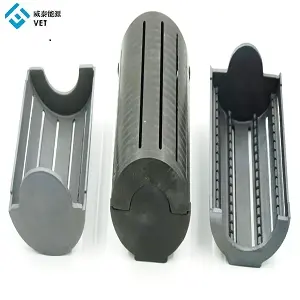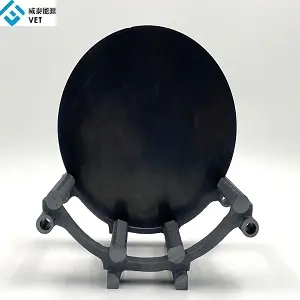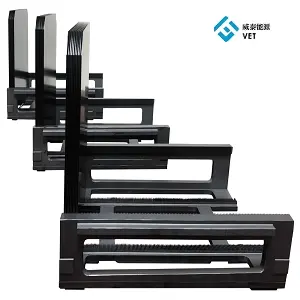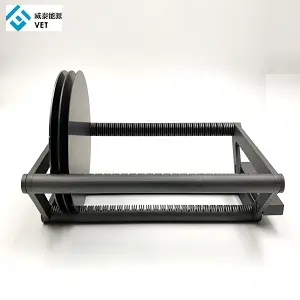
Silicon carbide ceramics have revolutionized semiconductor manufacturing by addressing critical diffusion challenges. The SiC Wafer Boat, crafted from this advanced material, offers unmatched thermal stability, chemical resistance, and mechanical strength. Its high thermal conductivity ensures uniform heat distribution, reducing defects during high-temperature processes. Ningbo VET Energy Technology Co. delivers SiC towers and silicon carbide boats designed to enhance efficiency and scalability in production environments.
SiC wafer ships also support automated handling systems, streamlining operations and minimizing human error, which is vital for managing larger wafer sizes.
Key Takeaways
- SiC Wafer Boats stay stable in heat, spreading warmth evenly. This lowers mistakes and boosts success in making semiconductors.
- SiC Wafer Boats resist chemicals, stopping dirt and keeping wafers clean. This helps meet strict purity rules for production.
- Using SiC Wafer Boats saves money by cutting repairs and delays. It makes factories work better and grow more easily.
Diffusion Challenges in Semiconductor Manufacturing

Contamination Risks and Their Impact on Product Quality
Contamination remains one of the most critical challenges in semiconductor manufacturing. Even the smallest impurity can compromise product quality, leading to significant financial losses. For instance, ultra-high purity (UHP) gases with a purity level of 99.999% are essential for maintaining clean processing environments. A single contaminant molecule can cause defects severe enough to necessitate scrapping entire batches of wafers, costing manufacturers millions of dollars.
| Metric | Description |
|---|---|
| Purity Levels of Gases | Required purity levels for gases used in manufacturing, e.g., nitrogen at 99.999% purity. |
| Detection Limits for Impurities | The need for detection limits to go beyond parts per billion (ppb) to parts per trillion (ppt). |
| Impact of Contamination | Even a single contaminant molecule can lead to catastrophic defects, affecting product quality. |
The SiC Wafer Boat offers exceptional chemical resistance, preventing contamination during high-temperature processes. This ensures that manufacturers can maintain the stringent purity standards required for semiconductor production.
Thermal Instability in High-Temperature Processes
High-temperature processes, such as diffusion and epitaxy, often face challenges related to thermal instability. Fluctuations in temperature can lead to defects in silicon wafers, reducing yield and increasing production costs. Research shows that mechanical and thermal stress during heat treatment can cause elastic deformation or even permanent damage to wafers.
- SiC coated susceptors provide a stable platform for wafers during epitaxy, ensuring consistent temperature conditions.
- They excel in thermal stability and chemical resistance, which is vital for high-quality semiconductor fabrication.
- The targeted heating from SiC coated susceptors reduces defects and improves substrate quality, leading to higher yields in semiconductor manufacturing.
The SiC Wafer Boat, with its high thermal conductivity and low coefficient of thermal expansion, ensures uniform heat distribution and stability, minimizing the risks associated with thermal fluctuations.
Material Degradation and Maintenance Costs
Material degradation is another significant challenge in semiconductor manufacturing. Frequent exposure to high temperatures and corrosive chemicals accelerates wear and tear, leading to increased maintenance costs and production downtime. Traditional materials like quartz and graphite often fail to withstand these harsh conditions over extended periods.
The SiC Wafer Boat, crafted from silicon carbide, offers superior durability and resistance to corrosion. Its hardness, second only to diamond, ensures long-term reliability, reducing the need for frequent replacements. This translates to lower maintenance costs and improved operational efficiency for manufacturers.
How SiC Wafer Boat Solves Diffusion Challenges

High Thermal Conductivity for Uniform Heat Distribution
The SiC Wafer Boat excels in high-temperature diffusion processes due to its remarkable thermal conductivity. Silicon carbide’s ability to transfer heat efficiently ensures uniform temperature distribution across the wafer surface. This uniformity minimizes thermal gradients, which often lead to defects such as warping or cracking.
- The design of SiC wafer boats accommodates varying wafer sizes, enhancing structural integrity during high-temperature operations.
- Larger wafers benefit from reinforced frameworks, reducing the risk of misalignment or damage.
- This stability directly addresses diffusion challenges, improving yield rates in semiconductor manufacturing.
By maintaining consistent thermal conditions, the SiC Wafer Boat supports critical processes like doping and etching, essential for producing advanced semiconductor devices.
Exceptional Chemical Resistance to Prevent Contamination
Chemical resistance is a defining feature of the SiC Wafer Boat, making it indispensable in semiconductor manufacturing. Silicon carbide resists corrosion from strong acids and alkalis, ensuring a clean processing environment. This property prevents unwanted chemical reactions with processing gases, which could otherwise introduce contaminants.
| Feature | SiC Wafer Boats | Traditional Materials |
|---|---|---|
| Temperature Resistance | Exceptional, withstands extreme temps | Limited, prone to degradation |
| Chemical Corrosion Resistance | High, resists chemical corrosion | Low, susceptible to corrosion |
| Mechanical Stability | Maintains stability under stress | Often unstable under high stress |
The SiC Wafer Boat’s high purity and chemical resilience make it ideal for high-temperature diffusion processes, safeguarding wafer quality and enhancing production efficiency.
Superior Mechanical Strength for Long-Term Reliability
The mechanical strength of the SiC Wafer Boat ensures long-term reliability in demanding manufacturing environments. Silicon carbide’s hardness, second only to diamond, allows it to withstand mechanical stress without deformation. This durability reduces the need for frequent replacements, lowering maintenance costs and minimizing downtime.
Material tests confirm the superior strength of SiC. For instance, its yield compressive strength is 180% higher than traditional materials, while its ultimate compressive strength is 101% greater. These properties make the SiC Wafer Boat a robust solution for high-performance applications, ensuring stability and reliability over extended periods.
The SiC Wafer Boat’s mechanical and thermal properties make it a cornerstone of modern semiconductor manufacturing, addressing challenges with unmatched efficiency.
Why SiC Wafer Boat Outperforms Alternative Materials

SiC vs. Quartz: Durability and Thermal Stability
Silicon carbide (SiC) surpasses quartz in both durability and thermal stability, making it the preferred choice for semiconductor manufacturing. SiC exhibits exceptional resistance to thermal stress, ensuring consistent performance even in extreme conditions. Its ability to withstand temperatures up to 1800 °C without degradation highlights its superiority over quartz, which lacks the mechanical strength required for prolonged high-temperature applications.
- SiC coated susceptors enhance performance in MOCVD processes by enduring harsh environments.
- Quartz, while thermally stable, cannot match the chemical resistance and structural integrity of SiC.
- SiC’s robust framework minimizes the risk of cracking or deformation, ensuring long-term reliability.
These attributes make the SiC Wafer Boat an indispensable tool for manufacturers seeking to optimize their production processes.
SiC vs. Graphite: Chemical and Mechanical Advantages
SiC offers significant advantages over graphite in semiconductor manufacturing, particularly in demanding processes like epitaxial growth. Its superior chemical resistance prevents corrosion and oxidation, ensuring wafer integrity during high-temperature diffusion. Unlike graphite, which degrades under harsh conditions, SiC maintains its stability, leading to improved yield and device reliability.
The mechanical strength of SiC further enhances its appeal. Its hardness, second only to diamond, allows it to withstand mechanical stress without deformation. This durability reduces maintenance needs, making it a cost-effective solution for high-performance applications. By choosing SiC over graphite, manufacturers can achieve higher-quality semiconductor devices with fewer defects.
The Long-Term Benefits of Choosing SiC Wafer Boats
The long-term benefits of SiC Wafer Boats extend beyond their immediate performance advantages. Their durability reduces the frequency of replacements, lowering maintenance costs and minimizing production downtime. The high thermal conductivity of SiC ensures uniform heat distribution, improving wafer quality and yield rates. Additionally, their chemical resistance safeguards against contamination, maintaining the purity standards essential for semiconductor manufacturing.
By investing in SiC Wafer Boats, manufacturers can enhance operational efficiency, reduce costs, and achieve consistent results. These benefits make SiC the material of choice for those aiming to stay competitive in the rapidly evolving semiconductor industry.
Benefits of SiC Wafer Boat for Manufacturers
Cost Savings Through Reduced Downtime and Maintenance
The SiC Wafer Boat offers manufacturers significant cost savings by reducing downtime and maintenance requirements. Its exceptional durability, derived from silicon carbide’s hardness and resistance to wear, ensures long-term reliability. Unlike traditional materials, which degrade quickly under high temperatures and corrosive environments, the SiC Wafer Boat maintains its structural integrity. This reduces the frequency of replacements and minimizes production interruptions.
Additionally, its low coefficient of thermal expansion prevents deformation during rapid temperature changes, further enhancing its lifespan. Manufacturers benefit from fewer maintenance cycles, leading to lower operational costs and improved productivity.
Improved Yield and Product Quality
The SiC Wafer Boat plays a crucial role in improving yield and product quality in semiconductor manufacturing. Its high thermal conductivity ensures uniform heat distribution, eliminating thermal gradients that can cause defects like warping or cracking. This uniformity is essential for maintaining the structural integrity of wafers during high-temperature processes.
Moreover, its superior chemical resistance prevents contamination from corrosive substances, safeguarding the purity of the wafers. By maintaining stringent quality standards, the SiC Wafer Boat helps manufacturers achieve higher yields and produce defect-free semiconductor devices.
Enhanced Efficiency and Scalability in Production
The SiC Wafer Boat enhances production efficiency and scalability by addressing the challenges of handling larger wafer sizes. Its design ensures precise wafer alignment and stability, which are critical for maintaining high yield rates. Features like enhanced thermal stability and chemical resistance enable it to handle larger wafers effectively, supporting scalability in manufacturing.
- SiC wafer boats optimize production efficiency by reducing manual intervention through automated handling systems.
- Their robust construction minimizes the risk of misalignment or damage, ensuring consistent performance.
- These attributes make them indispensable for manufacturers aiming to scale operations while maintaining efficiency.
By integrating advanced SiC Wafer Boats into their processes, manufacturers can streamline operations, reduce errors, and meet the demands of modern semiconductor production.
SiC Wafer Boats deliver unmatched performance in semiconductor manufacturing by addressing critical diffusion challenges. Their ability to withstand extreme temperatures, resist chemical corrosion, and maintain mechanical stability ensures superior results compared to quartz and graphite. These features make them indispensable for high-performance applications, especially in environments requiring enhanced thermal stability and chemical resistance. Ningbo VET Energy Technology Co. provides high-quality SiC Wafer Boats, enabling manufacturers to achieve cost-effective, scalable, and efficient production processes.
📌 SiC Wafer Boats offer a longer operational lifespan, making them a reliable and cost-effective choice for high-volume semiconductor production.
FAQ
What makes SiC Wafer Boats superior to traditional materials?
SiC Wafer Boats excel due to their high thermal conductivity, chemical resistance, and mechanical strength. These properties ensure durability, efficiency, and reliability in semiconductor manufacturing processes.
Can SiC Wafer Boats handle extreme temperatures?
Yes, SiC Wafer Boats withstand temperatures up to 1800 °C. Their thermal stability ensures consistent performance during high-temperature diffusion processes, reducing defects and improving wafer quality.
How do SiC Wafer Boats improve production efficiency?
SiC Wafer Boats enhance efficiency by minimizing downtime, reducing maintenance needs, and supporting automated handling systems. Their durability and stability optimize semiconductor manufacturing operations.






